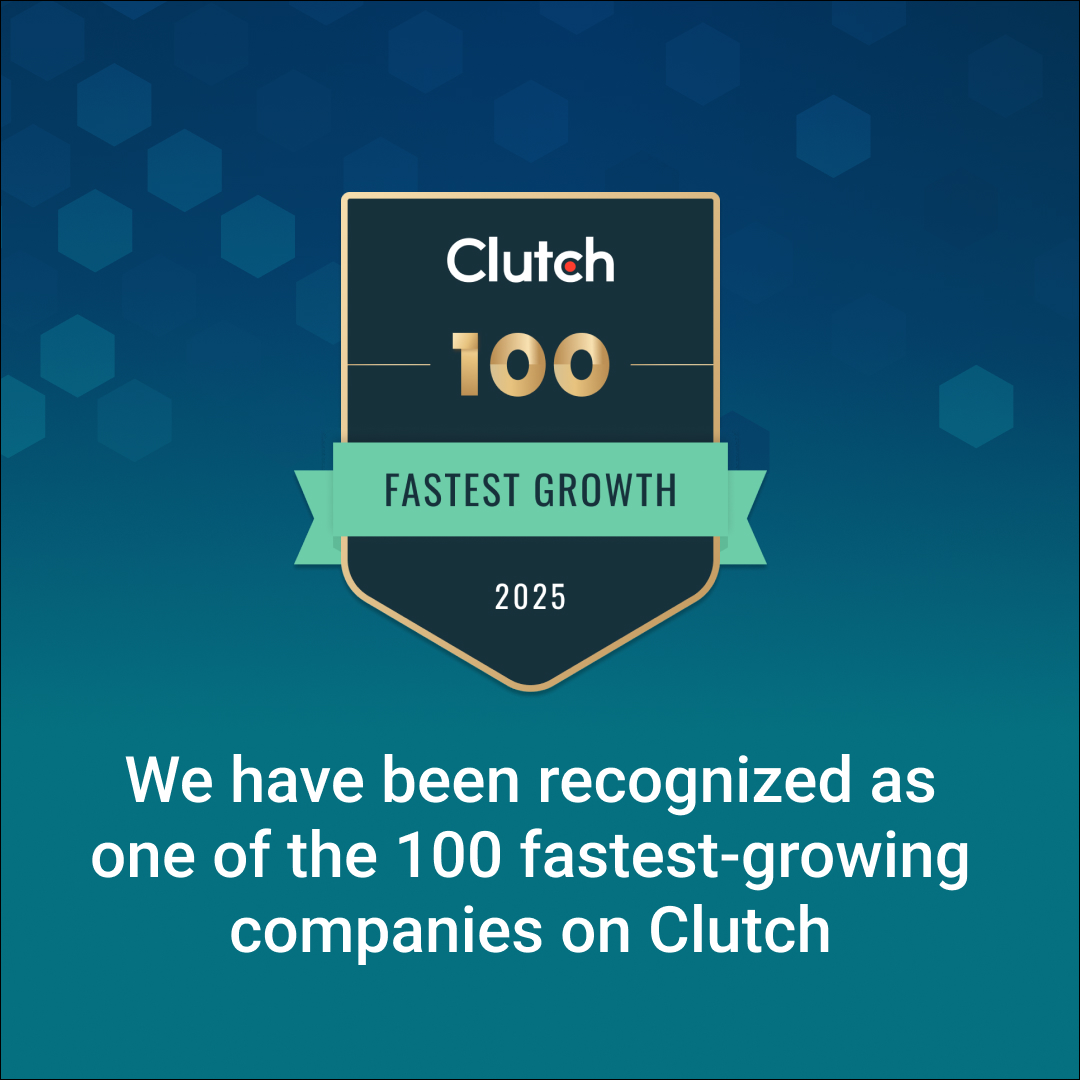Introduction
The oil and gas industry faces mounting challenges, from volatile commodity prices to complex operational risks and increasing pressure for sustainability. AI is rapidly emerging as a critical tool to tackle these issues by optimizing exploration, improving safety, enhancing predictive maintenance, and driving operational efficiency.
This guide explores how AI-driven use cases are reshaping oil and gas into a smarter, more resilient sector.
As the oil and gas industry embraces AI to tackle complex challenges and optimize operations, integrating these innovations into comprehensive solutions is key. To understand how end-to-end ai-powered software development transforms AI concepts into reliable, scalable applications, explore our dedicated services designed to deliver measurable business impact.
What is AI and Why Does It Matter in Oil and Gas Industry?
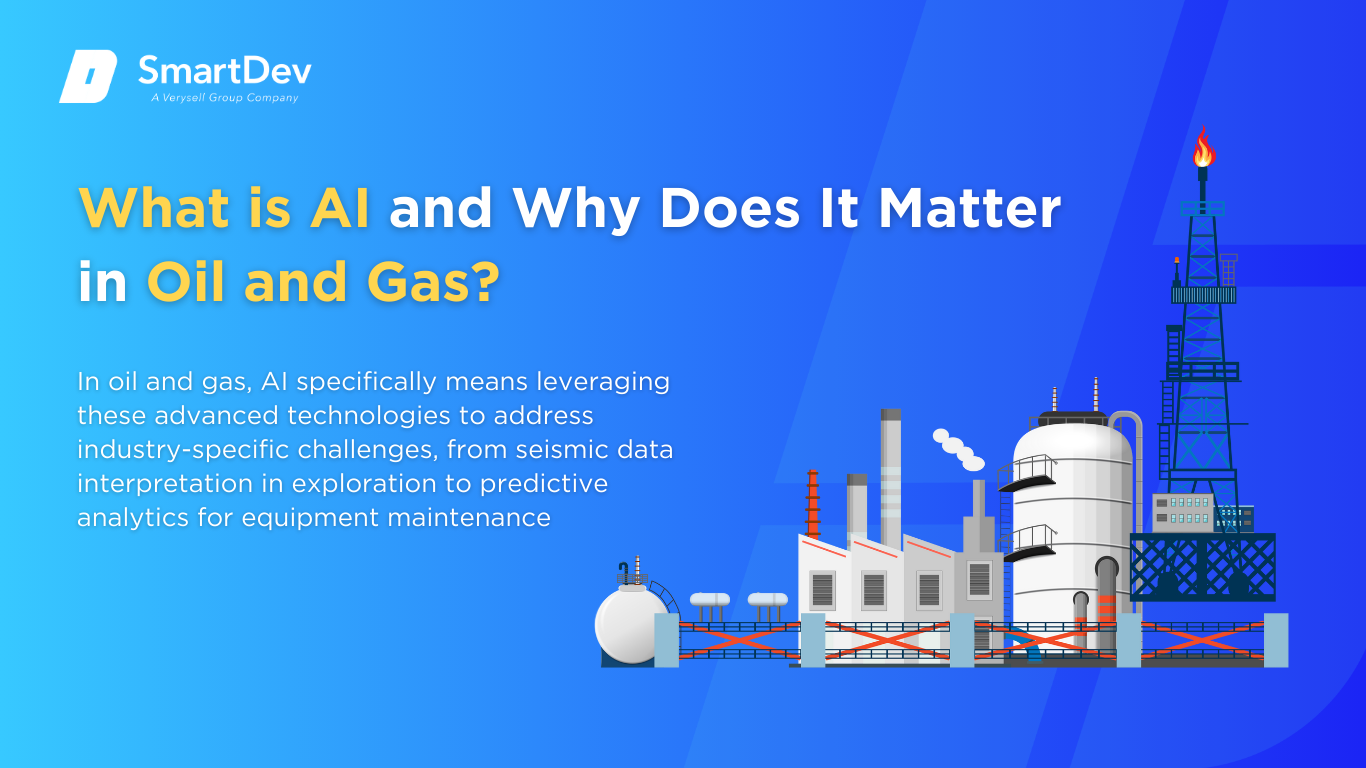
Definition of AI and Its Core Technologies
Artificial Intelligence (AI) refers to computer systems designed to perform tasks that typically require human intelligence, such as learning, reasoning, and problem-solving. Core technologies underpinning AI include machine learning (ML), natural language processing (NLP), and computer vision, enabling machines to analyze data, detect patterns, and make decisions with minimal human intervention.
In oil and gas, AI specifically means leveraging these advanced technologies to address industry-specific challenges, from seismic data interpretation in exploration to predictive analytics for equipment maintenance. AI systems help companies reduce operational risks, optimize resource allocation, and improve decision-making in a data-heavy environment.
The Growing Role of AI in Transforming Oil and Gas Industry
AI’s impact in oil and gas extends across the value chain, from upstream exploration to downstream refining and distribution. Exploration teams increasingly rely on AI-powered seismic analysis to identify hydrocarbon deposits faster and with higher accuracy, reducing the risk of dry wells and costly errors. These AI models analyze complex geological data, accelerating decisions on drilling locations.
In production and operations, AI-driven predictive maintenance models monitor equipment health in real time. By analyzing sensor data from pumps, compressors, and pipelines, these models forecast failures days or weeks in advance, enabling proactive maintenance and avoiding unscheduled shutdowns. This shift dramatically improves asset uptime and safety compliance.
Downstream, AI optimizes refinery processes and supply chain logistics. For example, AI systems forecast demand fluctuations and optimize inventory management, preventing costly overstocking or shortages. AI also enhances safety monitoring by analyzing video feeds and sensor data to detect hazardous conditions or leaks early, reducing environmental impact and improving regulatory compliance.
Key Statistics and Trends Highlighting AI Adoption in Oil and Gas Industry
AI is transforming the oil and gas industry, with AI use cases in oil and gas driving significant operational improvements. A 2023 Ernst & Young survey indicates that 92% of oil and gas companies are investing in or planning to adopt AI within five years, reflecting its growing importance. These investments focus on enhancing efficiency, safety, and decision-making in a volatile market.
AI adoption in oil and gas is yielding measurable cost savings and operational benefits. According to a 2024 BCG report, AI applications can reduce production and maintenance costs by up to 20% through predictive maintenance and optimized workflows. Companies leveraging AI for real-time data analytics are minimizing downtime and improving asset performance.
The global AI in oil and gas market is experiencing robust growth, fueled by technological advancements. Allied Market Research reports the market was valued at $2.32 billion in 2021 and is projected to reach $7.99 billion by 2031, growing at a CAGR of 13.5%. AI-driven innovations in seismic data analysis and automation are positioning oil and gas firms for enhanced competitiveness and sustainability.
Business Benefits of AI in Oil and Gas Industry
AI delivers tangible business value by solving pressing operational challenges, cutting costs, and enhancing decision-making accuracy. Here are five key benefits:
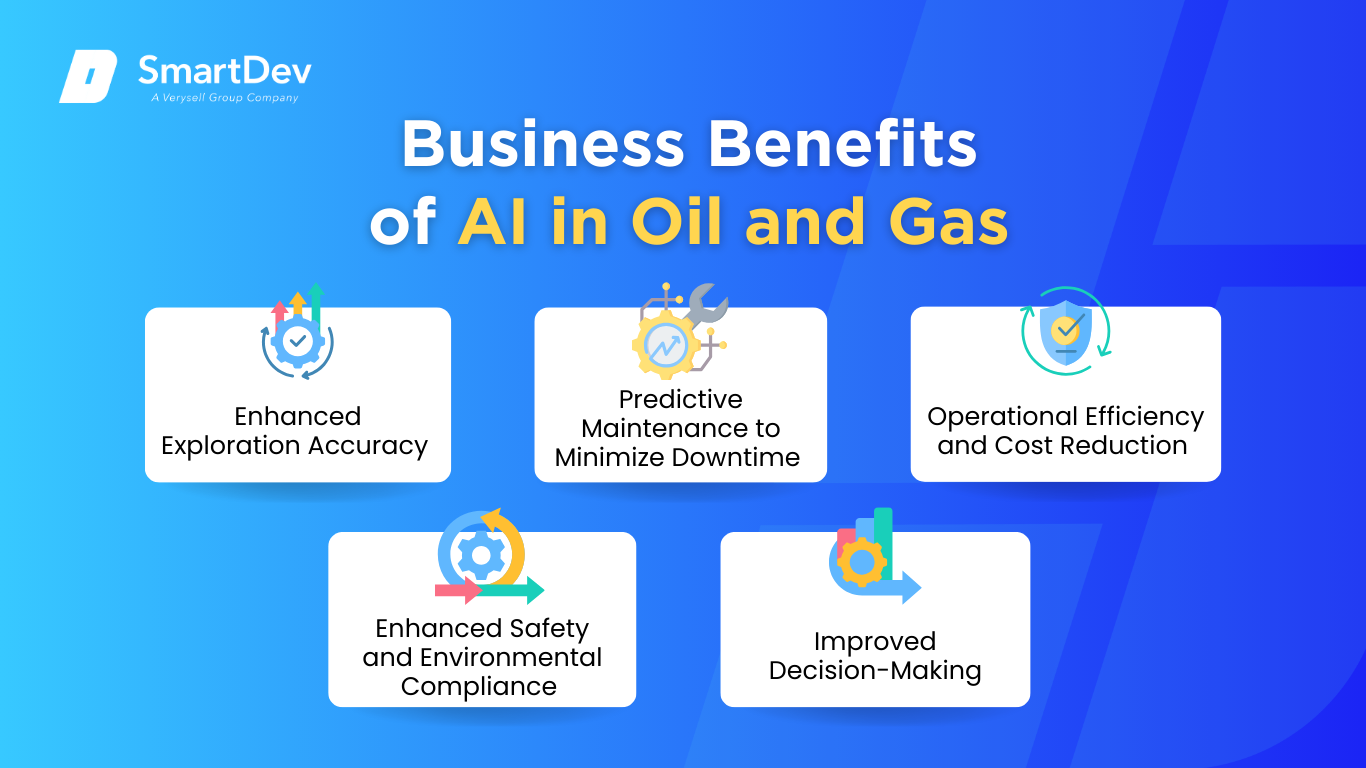
1. Enhanced Exploration Accuracy
AI algorithms analyze seismic and geological data to identify oil and gas deposits more precisely than traditional methods. This reduces the risk of dry wells and unnecessary drilling, directly cutting exploration costs. For example, Shell uses AI to speed up seismic data processing, improving reservoir characterization and decision speed.
By automating data interpretation, AI shortens exploration timelines and improves the chances of successful drilling. This efficiency supports better capital allocation and minimizes environmental disturbances.
2. Predictive Maintenance to Minimize Downtime
Industrial equipment failures cause costly downtime and safety risks in oil and gas operations. AI predictive maintenance models use real-time sensor data to forecast potential failures before they occur. BP reports that predictive analytics have reduced maintenance costs by 10% and equipment downtime by 20%.
This proactive maintenance strategy enhances asset reliability by identifying anomalies early, even in complex machinery operating under extreme conditions. It also helps extend equipment life, reduce spare parts inventory, and avoid catastrophic failures that can halt production entirely.
3. Operational Efficiency and Cost Reduction
AI optimizes drilling operations, reservoir management, and supply chain logistics. For example, AI-powered drilling simulators help operators adjust parameters in real time to maximize output and reduce costs. AI-based supply chain tools improve demand forecasting and inventory management, preventing stockouts or surplus.
By continuously analyzing production data, AI identifies underperforming assets and inefficiencies, allowing targeted interventions. These insights support real-time operational decisions that lead to measurable gains in throughput, resource use, and margin performance.
4. Enhanced Safety and Environmental Compliance
AI-enabled monitoring systems analyze video footage, sensor data, and weather conditions to detect hazards such as gas leaks, equipment malfunctions, or unsafe worker behavior. Chevron uses AI-powered safety analytics to reduce incident rates by identifying risk patterns early.
Advanced models can distinguish between normal and hazardous conditions with high accuracy, reducing false alarms and response time. At the same time, AI improves transparency and auditability, easing the burden of regulatory compliance and enhancing stakeholder trust.
5. Improved Decision-Making with Data-Driven Insights
AI consolidates vast amounts of structured and unstructured data into actionable insights. Decision-makers benefit from predictive models and dashboards that visualize operational risks, production forecasts, and market trends. ExxonMobil has integrated AI to enhance project risk analysis and investment decisions.
These systems uncover correlations across domains, such as geology, logistics, and market signals that human analysts might overlook. The result is faster, more informed strategic decisions that improve agility in a highly volatile energy market.
Challenges Facing AI Adoption in Oil and Gas Industry
Despite the clear benefits, implementing AI in oil and gas presents significant challenges:
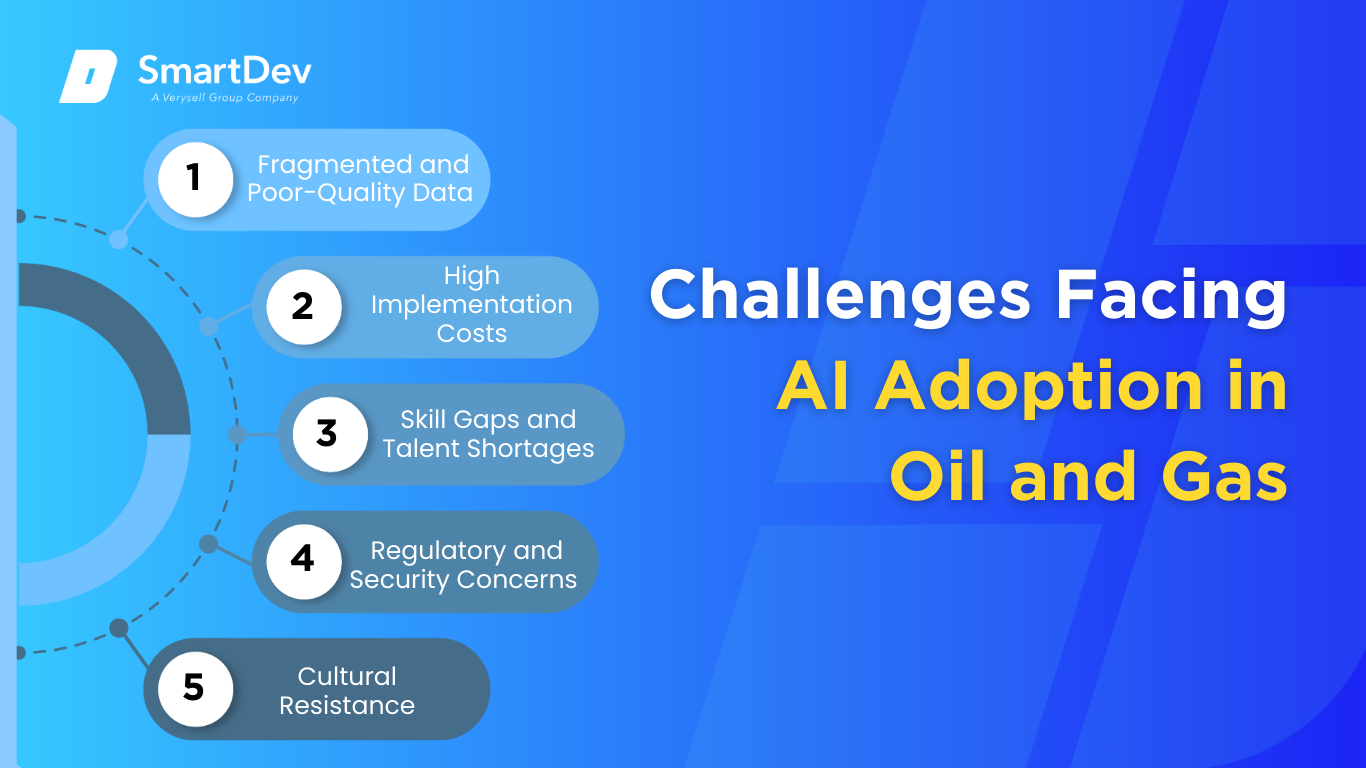
1. Fragmented and Poor-Quality Data
AI’s effectiveness depends on clean, comprehensive data. However, oil and gas companies often struggle with fragmented data spread across legacy systems, spreadsheets, and siloed departments. Without unified and accurate data, AI models produce unreliable results, limiting their impact.
In upstream operations, for example, inconsistent seismic data or incomplete well logs can lead to incorrect reservoir predictions. The challenge is compounded by decades of disconnected data systems across exploration, drilling, production, and compliance workflows.
2. High Implementation Costs and Integration Complexity
Deploying AI solutions requires substantial upfront costs, including software, hardware, and specialized talent. Integrating AI into existing infrastructure, especially in remote or hazardous environments, adds further complexity and risk. These challenges deter many companies, particularly smaller operators with limited budgets.
In offshore platforms or aging refineries, retrofitting legacy assets with AI-ready sensors and connectivity infrastructure can require multimillion-dollar investments. These costs are hard to justify without clear short-term ROI, slowing enterprise-wide adoption.
3. Skill Gaps and Talent Shortages
Oil and gas firms face a shortage of professionals skilled in AI, data science, and digital transformation. The specialized nature of the industry further narrows the talent pool. Without the right expertise, projects may fail to deliver expected outcomes or suffer delays.
Petrotechnical experts rarely have deep AI backgrounds, and data scientists often lack domain knowledge about subsurface geology or refinery processes. Bridging this interdisciplinary gap requires long-term investment in cross-functional training and strategic hiring.
4. Regulatory and Security Concerns
Data security is paramount in oil and gas, where sensitive information about assets and operations is targeted by cyber threats. Implementing AI introduces new vulnerabilities, requiring robust cybersecurity measures. Additionally, evolving regulations around data use and environmental impact create uncertainty that can slow AI adoption.
For example, AI systems analyzing pipeline data or emissions must comply with regional data sovereignty laws and environmental standards. Any breach or misinterpretation of regulatory data could lead to legal penalties or reputational damage.
5. Cultural Resistance and Change Management
While not simply “resistance to change,” cultural barriers stem from concerns about job displacement, trust in AI decisions, and shifts in operational workflows. For AI to succeed, companies need clear communication about AI’s role as an augmenting tool, not a replacement, and invest in change management to align teams around new processes.
In field operations, where decisions are often based on experience and instinct, employees may distrust algorithmic recommendations. Building user confidence requires phased implementation, hands-on training, and early success stories that validate AI’s value on the ground.
Specific Applications of AI in Oil and Gas Industry
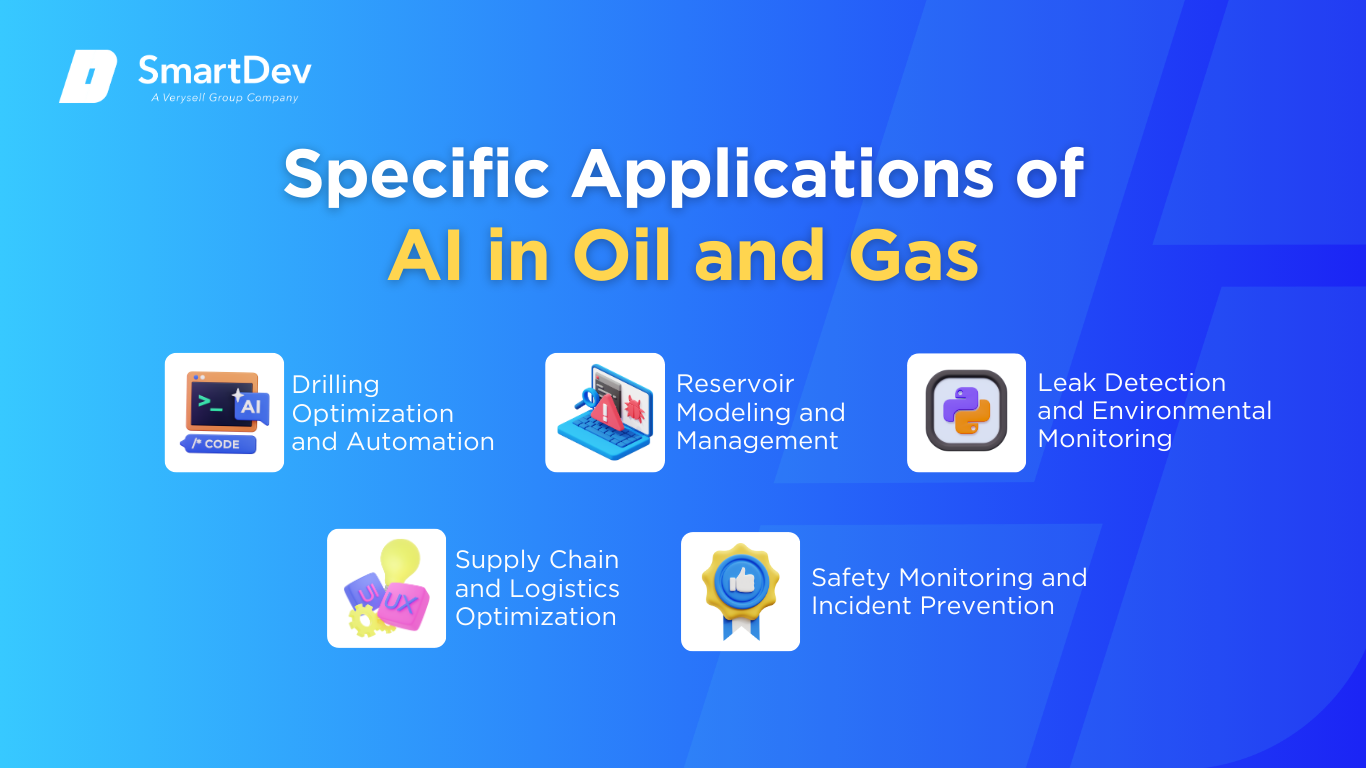
1. Drilling Optimization and Automation
AI optimizes drilling operations by analyzing real-time geological and operational data to adjust drilling parameters on the fly. Machine learning models process data from seismic sensors, mud logs, and historical drilling patterns to guide decision-making during drilling. This allows operators to identify the most efficient and safest drilling paths, minimizing non-productive time.
Advanced AI algorithms such as reinforcement learning and neural networks can dynamically adjust the weight-on-bit, rotation speed, and fluid pressures. These models integrate directly with drilling control systems to automate adjustments, reducing reliance on manual interventions. The result is faster, more precise drilling with fewer delays and cost overruns.
Example: BP has applied AI-driven optimization to steer drill bits and predict hazardous well conditions in real time. By leveraging predictive analytics, BP has managed to drill more wells annually and reduce overall project cycle times. These improvements have enhanced safety and yielded significant capital efficiency gains.
2. Reservoir Modeling and Management
AI enhances reservoir modeling by integrating large volumes of subsurface data into predictive simulations. Algorithms analyze seismic surveys, core samples, and production history to generate dynamic reservoir models. These models provide accurate forecasts of fluid behavior and reservoir performance under different production strategies.
Deep learning networks and top-down modeling approaches help engineers simulate various scenarios quickly without the traditional time-intensive methods. AI tools enable continuous model refinement as new data becomes available, increasing forecasting accuracy and decision confidence. This supports better planning for secondary recovery techniques and field development.
Example: Equinor applied AI to the Volve oil field to reduce the time required for reservoir simulations while maintaining high accuracy. Using machine learning-based modeling, the company improved production forecasts and optimized field operations. This led to enhanced recovery and minimized production risks.
3. Leak Detection and Environmental Monitoring
AI improves leak detection by using sensor data and visual inputs to identify anomalies that suggest emissions or equipment failure. Computer vision systems process imagery from drones or fixed cameras to detect gas plumes or pipeline leaks. These systems are trained on diverse datasets to recognize early-stage anomalies often missed by traditional inspections.
In addition, AI algorithms analyze acoustic, temperature, and pressure data from IoT-enabled sensors across facilities and pipelines. The systems trigger alerts when patterns deviate from expected norms, helping crews intervene promptly. This not only protects the environment but also prevents costly shutdowns or regulatory penalties.
Example: Chevron deploys AI-powered drones at its shale operations to scan infrastructure for gas leaks and maintenance needs. The system automatically flags abnormal emissions, enabling rapid response and reduced methane release. This has improved both environmental compliance and operational reliability.
4. Supply Chain and Logistics Optimization
AI streamlines oil and gas supply chains by predicting demand and optimizing logistics routes. Machine learning models process historical data, market trends, and external disruptions (like weather or geopolitical events) to generate optimal transport and inventory plans. These tools enhance forecasting accuracy and reduce inventory mismatches.
AI also supports dynamic logistics adjustments using real-time data from GPS, shipping logs, and sensor feeds. It can reroute shipments, consolidate loads, and automate procurement decisions. These capabilities ensure smoother supply chain operations, lowering costs and improving service reliability.
Example: ADNOC has integrated more than 30 AI systems across its logistics and operations chain. This initiative has saved $500 million in 2023 alone and helped avoid up to 1 million tons of CO₂ emissions. The AI tools improved procurement, fleet management, and downstream delivery scheduling.
5. Safety Monitoring and Incident Prevention
AI enhances safety monitoring by evaluating data from cameras, sensors, and wearables to identify risky behaviors and unsafe conditions. Systems powered by computer vision can detect when workers are not wearing safety gear or are operating machinery unsafely. AI also uses natural language processing to analyze incident reports and predict future risks.
Advanced risk models combine operational and environmental data to simulate emergency scenarios and assess vulnerabilities. These models support real-time safety dashboards and decision-making tools for supervisors. The result is a proactive safety culture with faster response to potential hazards.
Example: The Port of Corpus Christi implemented the OPTICS system, an AI platform that tracks ships and monitors for potential emergencies. It predicts vessel trajectories and alerts operators to risks, supporting safer navigation and emergency preparedness. This initiative has enhanced maritime safety and reduced incident response times.
Examples of AI in Oil and Gas Industry
Real-World Case Studies
The practical implementation of AI in the oil and gas industry showcases its transformative impact. The following case studies highlight successful AI applications across various operations.

Shell: Scaling Predictive Maintenance with AI
Shell was encountering significant challenges due to equipment failures across its refineries and upstream assets, leading to unplanned outages and excessive maintenance costs. Traditional maintenance approaches based on fixed schedules were inefficient and failed to address real-time equipment conditions. As a result, asset downtime had a tangible impact on production volumes and safety performance.
To address this, Shell implemented a predictive maintenance platform in collaboration with C3.ai, integrating machine learning models across over 10,000 equipment assets. These models process over 1.2 trillion data points annually from sensors and control systems, identifying patterns that precede mechanical failures. The system enables real-time monitoring and automated alerts, empowering maintenance teams to act before breakdowns occur.
The predictive maintenance initiative led to a 20% reduction in unplanned downtime and a 15% cut in maintenance expenditures. Additionally, Shell reported improvements in workforce efficiency and operational safety. This scalable AI solution not only lowered costs but also extended asset life and strengthened operational resilience.
BP: Enhancing Operational Efficiency through AI
BP’s refining operations were under pressure to become more efficient, especially amid tightening margins and rising environmental scrutiny. Energy losses and equipment inefficiencies were contributing to elevated operational costs and emissions. Conventional monitoring systems could not provide real-time insights or predict potential issues effectively.
To overcome these limitations, BP deployed AI solutions to digitize refinery operations, leveraging machine learning algorithms that interpret live data streams from IoT sensors embedded across process units. These models identify inefficiencies, predict potential equipment degradation, and suggest corrective actions. Decision-makers receive actionable insights via dynamic dashboards, allowing for real-time adjustments and smarter resource deployment.
Following AI integration, BP recorded a 20% increase in refining throughput efficiency and reduced maintenance-related disruptions by 25%. The system also contributed to emission control, aligning with sustainability goals. The initiative demonstrated how AI can drive high-impact improvements in large-scale industrial environments.
ADNOC: Integrating AI Across the Value Chain
As part of its digital transformation agenda, ADNOC aimed to modernize operations and meet aggressive climate targets without compromising production efficiency. The challenge was managing vast, complex oilfield data and making timely decisions across upstream, midstream, and downstream processes. The absence of centralized intelligence limited optimization potential.
ADNOC deployed over 30 AI systems to enhance capabilities across drilling, logistics, reservoir management, and environmental controls. These AI models are embedded within its Panorama Digital Command Center, aggregating real-time operational data and providing executives with analytics-based insights. Machine learning tools forecast supply-demand imbalances, while AI-driven simulations model optimal drilling and production strategies.
In 2023, ADNOC reported $500 million in value generated through AI applications, with substantial reductions in CO₂ emissions up to 1 million tons avoided in a year. The transformation streamlined decision-making, enhanced performance visibility, and supported ADNOC’s decarbonization roadmap. The initiative showcases how strategic AI deployment can simultaneously drive profitability and sustainability.
Port of Corpus Christi: Advancing Safety with AI-Powered Digital Twin
The Port of Corpus Christi, one of the busiest energy ports in the U.S., faced rising risks due to increased vessel traffic and evolving climate threats. Existing maritime surveillance systems offered limited predictive capability, constraining response times to emergencies and impeding safe navigation. There was a critical need for more advanced situational awareness.
In response, the port deployed OPTICS – a comprehensive AI platform that integrates machine learning, digital twin modeling, and generative AI. OPTICS simulates real-time vessel movements and generates emergency response training scenarios based on historical and environmental data. This proactive platform improves coordination between tugboats, control towers, and emergency services.
Since implementing OPTICS, the port has significantly reduced response times to vessel-related emergencies and improved maritime traffic flow. The platform has strengthened operational readiness and training outcomes, setting a new standard for AI in maritime infrastructure. The success highlights AI’s role in modernizing critical logistics hubs.
Innovative AI Solutions
Emerging AI technologies are reshaping the oil and gas industry by offering smarter, faster, and more adaptable solutions to complex challenges. Among the most transformative is generative AI, which allows operators to simulate and optimize drilling scenarios based on geological, historical, and operational data. This enables rapid exploration of alternatives, reducing risk and improving time-to-value in field development.
AI in reservoir engineering is also evolving rapidly, using machine learning to predict subsurface behaviors like pressure, permeability, and flow dynamics. These models continuously ingest new data, allowing reservoir plans to be refined in real time. This agility enhances recovery rates while minimizing the need for costly field experiments or conservative over-engineering.
Additionally, AI-powered acoustic technology is revolutionizing hydraulic fracturing diagnostics. Tools from companies like Seismos analyze sound reflections to detect fracture coverage and pinpoint leaks or inefficiencies. This real-time insight enables more accurate, efficient, and environmentally responsible well completions.
AI-Driven Innovations Transforming Oil and Gas Industry
Emerging Technologies in AI for Oil and Gas
Emerging AI technologies are reshaping the oil and gas industry by offering smarter, faster, and more adaptable solutions to complex challenges. Among the most transformative is generative AI, which allows operators to simulate and optimize drilling scenarios based on geological, historical, and operational data. This enables rapid exploration of alternatives, reducing risk and improving time-to-value in field development.
AI in reservoir engineering is also evolving rapidly, using machine learning to predict subsurface behaviors like pressure, permeability, and flow dynamics. These models continuously ingest new data, allowing reservoir plans to be refined in real time. This agility enhances recovery rates while minimizing the need for costly field experiments or conservative over-engineering.
Additionally, AI-powered acoustic technology is revolutionizing hydraulic fracturing diagnostics. Tools from companies like Seismos analyze sound reflections to detect fracture coverage and pinpoint leaks or inefficiencies. This real-time insight enables more accurate, efficient, and environmentally responsible well completions.
AI’s Role in Sustainability Efforts
AI plays a pivotal role in promoting sustainability within the oil and gas sector. Predictive analytics enable companies to anticipate equipment failures and schedule maintenance proactively, reducing downtime and preventing environmental hazards. For example, AI algorithms analyze sensor data to predict pipeline corrosion, allowing for timely interventions that prevent leaks and spills.
Moreover, AI optimizes energy consumption by analyzing usage patterns and identifying inefficiencies. Smart systems adjust operations to minimize energy waste, contributing to lower carbon emissions. These AI-driven initiatives align with global sustainability goals and demonstrate the industry’s commitment to environmental stewardship.
How to Implement AI in Oil and Gas Industry
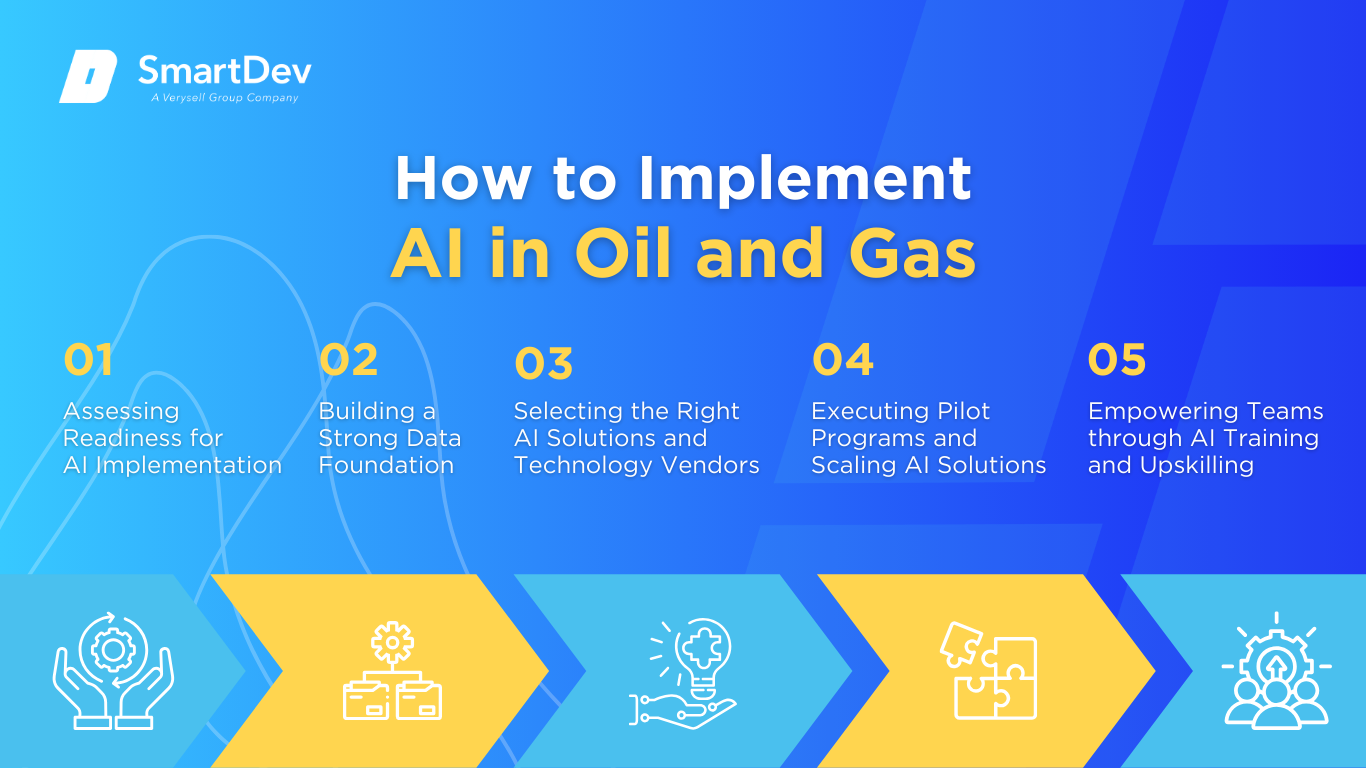
Step 1: Assessing Readiness for AI Adoption
To successfully integrate AI, companies must first evaluate where it can provide the most strategic value, whether in exploration, drilling, logistics, or maintenance. This requires a clear understanding of current workflows, data maturity, and employee capabilities. By pinpointing high-impact areas and aligning AI goals with business objectives, organizations can build a solid roadmap for adoption.
Step 2: Building a Strong Data Foundation
AI thrives on data, making quality and accessibility crucial. Oil and gas firms should prioritize consistent data collection from sensors, logs, and operational systems, followed by rigorous cleaning and validation. Establishing strong governance ensures the data remains secure, standardized and usable, creating the foundation for powerful AI insights.
Step 3: Choosing the Right Tools and Vendors
Selecting the right AI tools starts with understanding the specific needs of your operations. Partnering with vendors experienced in oil and gas helps ensure that solutions are practical, scalable, and compatible with existing infrastructure. Look for platforms that offer robust analytics, real-time processing, and ongoing support to ensure long-term success.
Step 4: Pilot Testing and Scaling Up
Before rolling out AI company-wide, it’s essential to start small. Pilot projects allow you to test assumptions, fine-tune algorithms, and prove ROI in a low-risk environment. Once the model is validated, scaling requires executive buy-in, change management, and a structured rollout plan that ensures consistency and buy-in across teams.
Step 5: Training Teams for Successful Implementation
AI success hinges on people. Upskilling your workforce to understand and leverage AI tools not only drives adoption but also fosters innovation. Offer targeted training programs and foster collaboration between data scientists, engineers, and domain experts to build a culture that embraces and scales AI across the organization.
Measuring the ROI of AI in Oil and Gas Industry
Key Metrics to Track Success
Evaluating the return on investment (ROI) of AI initiatives involves tracking specific metrics that reflect operational improvements and cost savings. Productivity enhancements, such as increased equipment uptime and reduced manual interventions, indicate the effectiveness of AI applications. For instance, predictive maintenance powered by AI can lead to a significant decrease in unplanned downtime, directly impacting productivity.
Cost savings achieved through automation and optimized processes are another critical metric. AI-driven efficiencies in exploration, drilling, and supply chain management reduce operational expenses. Additionally, monitoring environmental impact reductions, such as decreased emissions and energy consumption, highlights the sustainability benefits of AI integration.
Case Studies Demonstrating ROI
Real-world examples illustrate the tangible benefits of AI in the oil and gas industry. For instance, a major oil company implemented AI-powered predictive maintenance across its offshore platforms. By analyzing sensor data, the AI system identified potential equipment failures before they occurred, resulting in a 20% reduction in maintenance costs and a 15% increase in operational uptime.
Another case involves the use of AI in reservoir management. By integrating AI algorithms with geological data, a company optimized its drilling strategies, leading to a 10% increase in oil recovery rates. This not only enhanced profitability but also minimized environmental disruption by reducing the need for additional drilling sites.
Common Pitfalls and How to Avoid Them
Despite the advantages, AI implementation can encounter challenges. One common pitfall is the lack of clear objectives, leading to misaligned AI initiatives. To avoid this, companies should define specific goals and success criteria before deploying AI solutions.
Data quality issues can also hinder AI performance. Ensuring accurate and comprehensive data collection, along with robust data management practices, mitigates this risk. Additionally, resistance to change among employees may impede AI adoption. Addressing this through effective change management strategies and employee engagement fosters a supportive environment for AI integration.
Future Trends of AI in Oil and Gas Industry
Predictions for the Next Decade
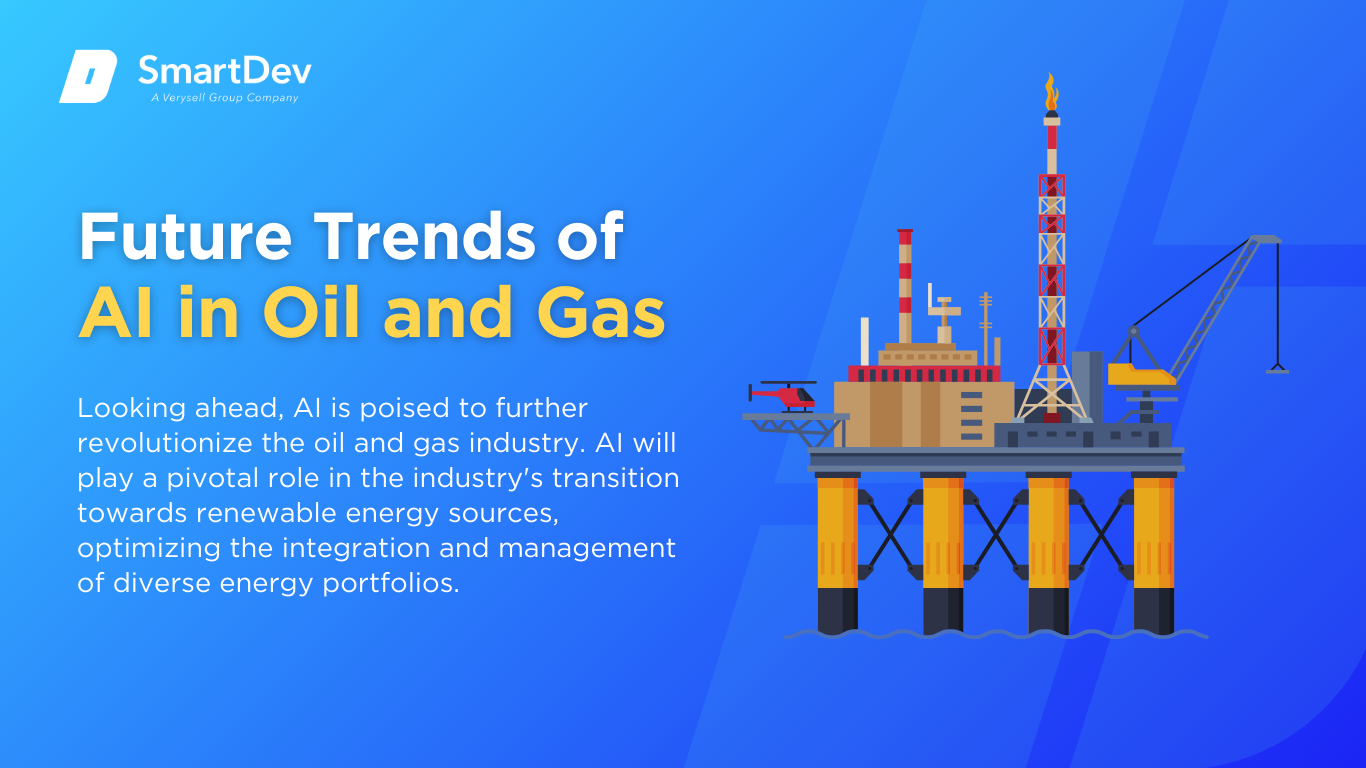
Looking ahead, AI is poised to further revolutionize the oil and gas industry. Advances in machine learning and data analytics will enable more precise exploration techniques, reducing the environmental footprint of drilling activities. AI-driven automation is expected to enhance safety by minimizing human exposure to hazardous conditions.
The integration of AI with other emerging technologies, such as the Internet of Things (IoT) and blockchain, will streamline operations and improve transparency. Additionally, AI will play a pivotal role in the industry’s transition towards renewable energy sources, optimizing the integration and management of diverse energy portfolios.
How Businesses Can Stay Ahead of the Curve
To remain competitive, oil and gas companies must proactively embrace AI innovations. This involves continuous investment in research and development, fostering partnerships with technology providers, and cultivating a culture of adaptability. Staying informed about emerging AI trends and regulatory changes ensures that businesses can anticipate and respond to industry shifts effectively.
Moreover, prioritizing sustainability and environmental responsibility in AI initiatives aligns companies with global expectations and positions them as leaders in the evolving energy landscape. By doing so, businesses not only future-proof their operations but also enhance their brand reputation and stakeholder trust in a rapidly transforming industry.
Conclusion
Key Takeaways
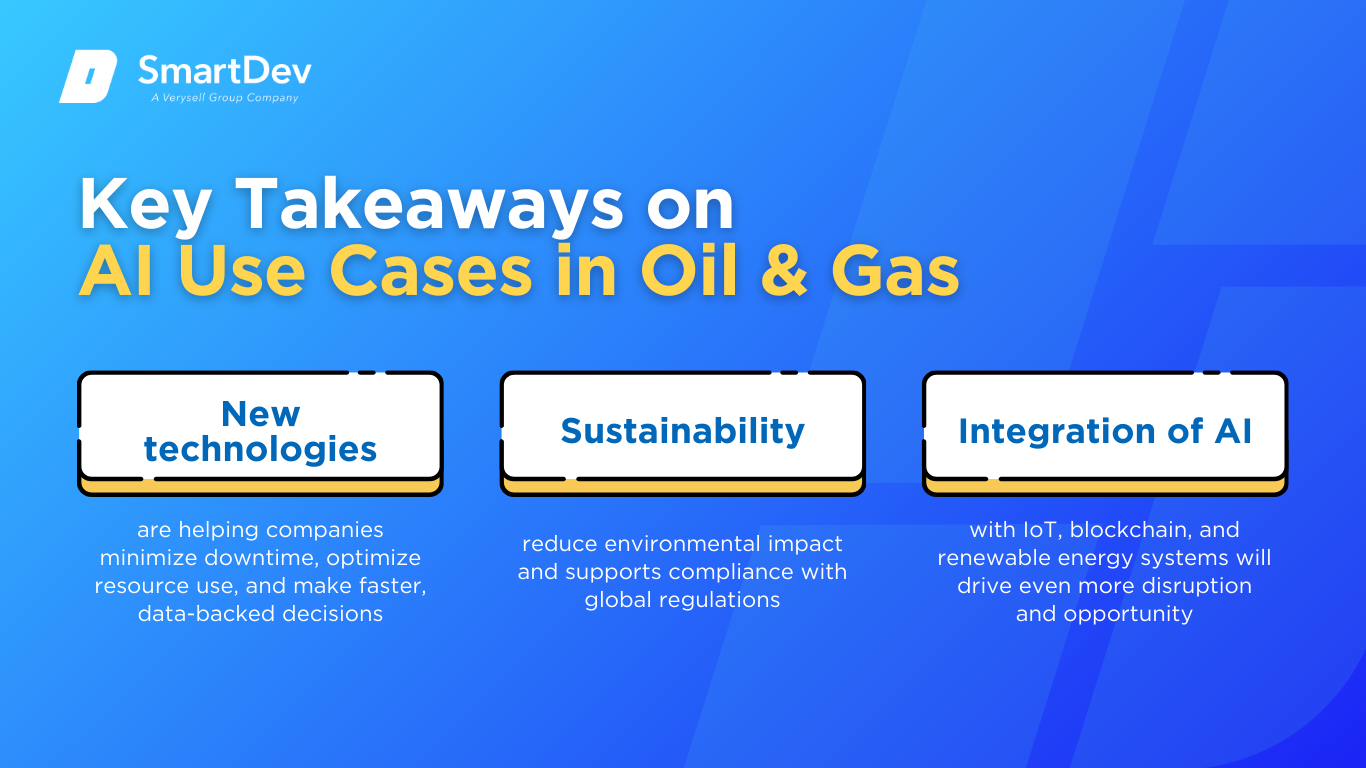
AI is rapidly redefining what’s possible in the oil and gas industry. From upstream exploration to downstream logistics, AI is delivering measurable gains in efficiency, safety, and sustainability. Technologies like predictive maintenance, generative AI, and computer vision are helping companies minimize downtime, optimize resource use, and make faster, data-backed decisions.
Sustainability is another critical frontier where AI is making its mark. By forecasting equipment failures and optimizing energy consumption, AI helps reduce environmental impact and supports compliance with global regulations. Real-world examples from industry leaders show that with the right approach, AI adoption can yield double-digit gains in uptime, cost savings, and productivity.
Looking forward, the integration of AI with IoT, blockchain, and renewable energy systems will drive even more disruption and opportunity. The companies that act now, invest wisely, and scale confidently will shape the next decade of oil and gas innovation.
Moving Forward: A Path to Progress
AI in oil and gas is becoming essential for companies looking to remain competitive, efficient, and sustainable in a volatile energy landscape. By starting today with data readiness, upskilling your teams, and selecting scalable AI platforms, your business can unlock significant operational and financial advantages.
At SmartDev, we partner with oil and gas leaders to deliver AI-powered solutions tailored to the industry’s most pressing challenges. From predictive maintenance and emissions monitoring to supply chain optimization and real-time field analytics, our experts bring cutting-edge tools that create measurable impact where it matters most.
Contact us today to discover how we can help transform your energy operations with AI. Let’s build a smarter, safer and more sustainable future for oil and gas together.
—
References:
- What Is Artificial Intelligence? | IBM Think
- Oil & Gas Industry Report | IFS
- AI-Powered R&D: Executive Perspectives | Boston Consulting Group (BCG)
- AI in Oil and Gas Market | Allied Market Research
- C3 AI and Shell Expand Collaboration for Asset Monitoring and Predictive Maintenance | C3.ai
- Deep Learning for Oil and Gas Data: A Case Study | Nature Scientific Reports
- ADNOC and AIQ Accelerate Deployment of Industry-First AR360 AI Solution | ADNOC
- Corpus Christi Port Uses AI for Ship Tracking and Emergency Training | Business Insider
- How the Port of Corpus Christi is Redefining Smart Port Operations | Port Technology


